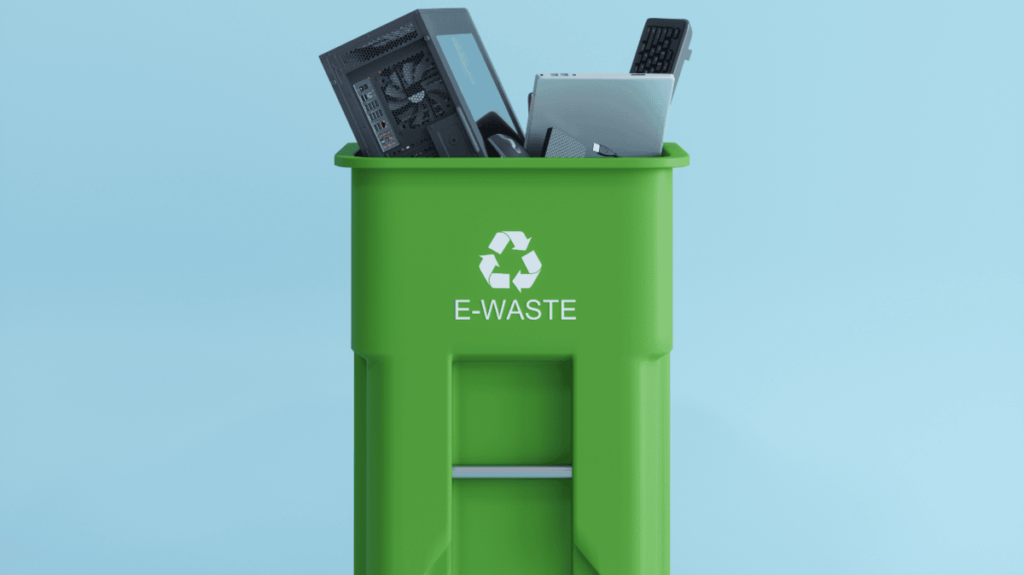The latest improvements in technology are some of the most impressive advances, as people seem to be changing their gadgets, like phones and laptops, at an even faster rate than ever before. Obsolete electronics from smartphones to laptops and now even television sets pile up, creating electronic waste or e-waste. Disposing of these devices the wrong way can cause huge danger to the environment and one’s health since all of them contain dangerous materials, such as lead, mercury, and cadmium.
Discarded electronics that are abandoned in landfills give out harmful substances that damage soil and water. However, proper disposal and e-waste recycling do reduce pollution, preserve precious resources, and promote environmental sustainability. In this article, we will discuss the most effective ways of handling e-waste, including recycling, donations, and government initiatives. All of us need to learn how to treat the leveraged resources in a way that has minimal environmental impact.
Electronic Waste and its Impact:
The current era’s technological advancements have led to e-waste becoming one of the rapidly increasing waste products. This is further fueled by people wanting new electronics. Each year, millions of tons of old electronics are thrown away, but only a small fraction is properly recycled. Society needs to understand that wasted electronics hold components such as gold, silver, copper, and even rare earth metals, all of which can be reused.
But instead of the recycling process, e-waste tends to, unfortunately, land in landfills and even be exported illegally to underdeveloped countries. There, unsafe dismantling exposed workers to poisonous chemicals. If no action is taken, the e-waste problem will worsen significantly and cause dire consequences for the environment.
Why Proper E-Waste Disposal Matters:
The environment and people’s health are severely affected by improper e-waste disposal. If sent to landfills, electronic waste (e-waste) contains numerous toxic materials that can leach into the soil and water. This, in turn, can damage ecosystems and wildlife. Furthermore, burning e-waste gives off toxic substances that contribute to air pollution and respiratory diseases.
On the other hand, responsible e-waste recycling helps conserve natural resources by recovering valuable materials that can be reused in new products, which lessens the need for mining and manufacturing. Those two processes alone are energy-hungry and environmentally destructive. By adopting proper disposal practices, individuals and businesses can greatly reduce the harmful effects of e-waste.
How to Recycle Electronics Safely and Responsibly:
Recycling electronics can help reduce e-waste, but it needs to be done properly. Several manufacturers and retailers have take-back policies that enable customers to bring back older devices for proper recycling. Certified e-waste recycling centers specialize in dismantling electronic items safely, recovering useful materials, and disposing of hazardous components responsibly.
Always ensure whichever recycler you choose follows accreditation and recycling ethics so that they do not violate basic environmental standards. Other organizations are known to make use of old electronics and reduce waste by refurbishing them. Consumers need to stop throwing electronics in general waste bins and instead seek out authorized recycling centers that have proper disposal methods.
Recycling and Donating Old Electronics:
Old electronics that aren’t in working order can still be useful. Many devices can be refurbished and donated to schools, charities, and non-profit organizations. Donating working electronics provides access to technology for students, low-income families, and community programs that lack funding. Some charities accept broken devices because they have the means to repair them before giving them out to other people.
Repurposing, reusing, and household electronics is another option; for instance, an old smartphone can be modified into a Stream or Media Player or serve as a security camera. Finding creative methods to prolong the lifespan of electronics reduces environmental waste and ensures the device’s value is maximized before disposal.
Government Policies and Initiatives for Managing E-Waste:
To tackle the increasing issue of e-waste, numerous governments have instituted policies and initiatives. Electronic waste disposal laws differ by country and region; in some, manufacturers are obligated to provide a recycling option for their products. EPR policies suggest that manufacturers of electronics should develop ways to collect old devices and make new ones easier to recycle, also known as product design for disassembly.
In certain locations, laws governing e-waste disposal are quite stringent; individuals or companies may be subject to fines for illegal disposal. Campaigns directed at the general population serve an important purpose in raising awareness concerning the responsible disposal of electronic waste. Learning about the laws governing e-waste in one’s area can empower citizens to act in good faith toward the environment.
The Contribution of Manufacturers to E-Waste Minimization:
Electronics companies have a responsibility to manage e-waste by adopting policies of sustainable design, consumption, and disposal. Most leading technology companies now manufacture products with modular parts, longer usability, and recyclable components to reduce waste. Some brands have introduced trade-in programs, which allow customers to surrender old devices for discounts on new ones.
Moreover, the use of energy-saving features and packaging also contributes to the eco-friendliness of the product. Sustainability is further advanced when consumers choose products from companies that provide sustainable e-waste management practices and take part in recycling programs. It is equally important to require responsibility from firms and their participation in e-waste reduction as a means to achieve a circular economy.
Issues Related To E-Waste Recycling:
There is a wide range of issues related to e-waste, such as no recycling awareness and the unavailability of proper recycling centers. One of the most common issues is a lack of awareness and recycling programs. E-waste does have complex materials that require specialized processes, which increases the cost of delivering components and illegally dudumped e-waste rates boundaries. Workers in other uncivilized countries without proper safety procedures expose themselves to hazardous substances, growing the number of issues related to e-waste. Solving the infrastructure problems, government policies, and enhancing the consumer law will cover a lot of barriers.
How Consumers Can Lower the E-Waste Problem:
To reduce e-waste further, people should be proactive in using electronic devices. Choosing only repairable/electric devices as per need and maintaining them prolongs the future need for replacements. Around the world, people are encouraged to sell or donate used electronics and not dispose of them by throwing them down their value. People can come forward in enabling e-waste awareness and recycling drives as they educate others to work towards e-waste disposal. Simple day-to-day practices from people across the world can give consumers a chance towards solving the e-waste issue from being too advanced.
The Outlook of E-Waste Management:
Inotex innovation challenge focusing on electronic waste management problems brings to light the fact that we need creative solutions for novel problems that accompany tech advancements. E-waste management requires more effective contemporary techniques for recovering materials out of the waste. The importance of developing new techniques is correlated with the expanding circular economy, which focuses on designing products for reuse and recyclability.
Developments in biodegradable materials and electronic components have the potential to mitigate eco-worries. Synergistic actions from consumers, governing bodies, and businesses are crucial towards mitigating the technological impact on the environment. Winds of change are on the rise with increasing eco-awareness.
Conclusion:
E-waste poses a challenge with global implications. However, its impact can be alleviated with proper disposal and recycling methods. When e-waste is disposed of correctly, the environment and ecosystems are protected while valuable resources are preserved. With the right approach, repurposing, donation, or recycling old electronics can aid the achievement of sustainable development.
Addressing this problem is the shared responsibility of individuals, governments, and manufacturers. Proper decision-making alongside the support of responsible e-waste recycling programs can help make a greener world possible without relinquishing the comforts brought about by technology. The onus is on every person to act and ensure that the e-waste we generate does not lead to further environmental degradation.
FAQs:
1. What happens to e-waste that is not recycled properly?
When e-waste is disposed of incorrectly, it is placed in landfills where it pollutes soil and groundwater. E-waste is also illegally sent to poorer nations where dangerous methods are used to dismantle electronics. Such practices put the health of the workers and environment in jeopardy.
2. How can I find a certified e-waste recycling facility?
Local authorities and manufacturers of electronic devices generally have details on certified e-waste recycling facilities. Websites such as Earth911 or e-Stewards are also useful resources for locating certified recycling centers.
3. Is it okay to just toss my old, broken electronics in the trash?
No, throwing away broken electronics is irresponsible and environmentally dangerous. A better option would be to give the electronics to a recognized recycler who can take them apart and reuse some of the parts or offer them to charity if they’re functional. Also, check whether the person who made them will accept them back.
4. Can all devices be disposed of correctly and reused?
Generally, most gadgets can be disposed of correctly and reused, but each device type, as well as the materials they contain, may affect how they are dismantled. Check with a local recycling center to see what services they offer.
5. What steps can I take to help lower my e-waste production?
Anyone can contribute to lowering e-waste by choosing to buy electronics made to last longer, donating an unused device, or recycling through programs that breakdown the devices, and using those materials to create new products. Being careful on how you buy things helps fight against the growing surplus of e-waste.

